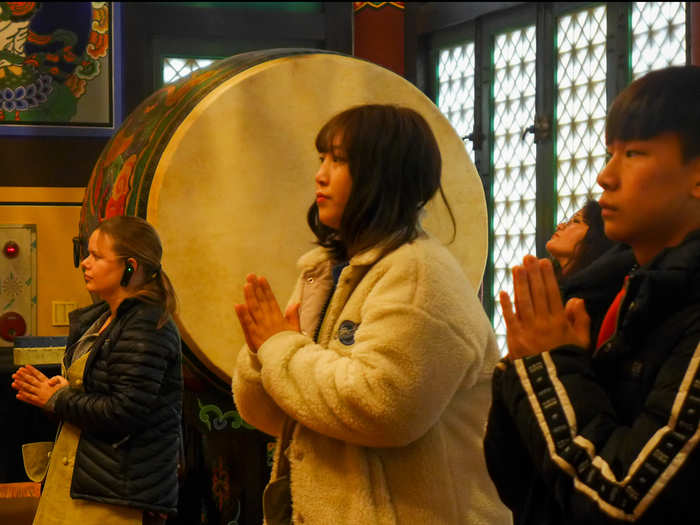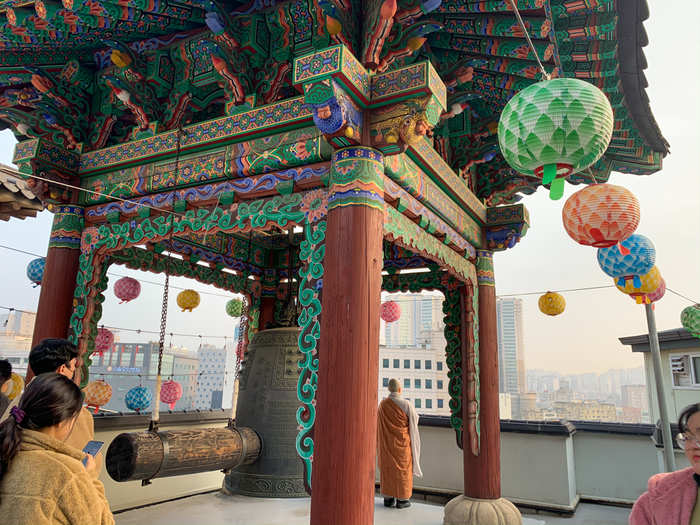- Home
- slideshows
- miscellaneous
- I paid $41 to sleep overnight at a Buddhist temple in South Korea, and after a month of staying in hostels and hotels it remains my favorite deal for travelers
I paid $41 to sleep overnight at a Buddhist temple in South Korea, and after a month of staying in hostels and hotels it remains my favorite deal for travelers
I stayed at the Myogaksa temple, which was conveniently located in Seoul.

Then, as I rounded the corner, I spotted the temple.

Alongside building after boring building is the door to the Myogaska temple. The temple was built in 1930, tucked away from the busy streets of Seoul.
Korean temple stays — spelled as Templestay as part of the official program — are a more recent invention. They began in 2002 as a way to give visitors and Koreans a deeper understanding of traditional Korean Buddhist practices during the Korea-Japan World Cup.
Inside the temple, the atmosphere couldn't be further than the hustle and bustle of the city.

The temple, snugly nestled into the side of a mountain, had a sense of stillness despite its central location. I signed up for the program called: "Where is your mind?" My decision was mostly driven by the fact that this was the most convenient program in Seoul for my schedule. But, I also hoped to reset my mind and take some time to reflect.
I headed inside the main, dorm-like building to pay my 500,000 won, or $41 dollars, for the program.

As instructed, I removed my shoes before entering the building. I was told that alcohol was banned, as was sharing a room with the opposite sex. Even if you're married, men and women are not allowed to share a room in the temple.
After paying, I was given a temple uniform of pants with a stretchy waist and a vest, as well as a room key to a room that I would share with a roommate.
My room was minimalist, to say the least.

There was nothing in the room except lockers and a small table. Outside, I had access to a communal bathroom, with toilets and showers. Me and my roommate were told that, at night, we would set up our own sleep rolls.
About an hour after arriving, I headed to the orientation.

Everyone in the program seemed to be heading to the orientation, even though it was thirty minutes before when I had been told the program was starting.
"Strange," I thought to myself. "I must have gotten the timing wrong."
Walking into the basement room where the orientation was held I was informed that I had not gotten the timing wrong — this was the orientation for Korean-speaking participants. The English orientation would be next; I was just the only foreigner on this particular weekend.
Typically, the groups are split half-and-half between Koreans seeking relaxation or a group bonding activity and foreign tourists. However, due to the coronavirus outbreak, all other English speakers had cancelled their visits.
Throughout my stay, everyone at the temple kindly included me despite being the only person who did not speak Korean.

If you're considering a temple stay and are concerned about the language barrier, I wouldn't let it worry you.
Other attendees were were eager to make sure I felt included, despite the fact that excessive chatting at the temple was discouraged. The sunim who lead the program was an emphatic and charismatic speaker. Even when she was speaking in Korean, her gestures and emphasis were so pronounced I found myself nodding or laughing along with the rest of the group.
The first activity of the temple stay was 108 prostrations.

Over and over, we bowed, extended the palms of your hands to the sky, and added another bead to a piece of string.
While the sunim explained the religious context of the activities, she also emphasized that everyone can take something away from these practices. Prostrations can help you connect your body and mind, as you bow dozens of times in a row. According to our sunim, it is also supposed to be a chance to rid your mind of laziness, greediness, and anger.
The prostrations were a good first step in getting into the right mindset for the program.

After the prostrations and the creation of a necklace of prayer beads, the sunim had everyone go around and say why they were attending for the weekend, translating their answers so I could understand. While a few people were there for religious reasons, most said they booked their stay because they needed to relax.
Next, we got a tour of the temple and rang the bell.

The temple bell rang out as we — seemingly lightly — hit it with a large, hanging piece of wood. The reverberations of the bell radiated out, through the group and echoing down the streets of Seoul.
It was around this point in the tour that I realized I should have packed shoes that slipped on and off more easily, as I was constantly was taking them on and off as we trekked through the courtyard from one building to another.
We also participated in our first Buddhist ceremony.

The master sunim lead the ceremony, following an explanation of the chants and rituals. This context was translated to me via earpiece by the sunim leading the program. Once the ceremony started, other participants and I followed along, following the example of the sunims as we completed more prostrations.
Dinner was a vegetarian feast.

Korean temple food is beloved outside of temples and has become famous far beyond South Korea. There is no meat or fish, and ingredients with particularly strong flavors including green onion, garlic, and MSG are banned. Just as our sunim explained that the body and mind are connected through both prostrations and meditation, she emphasized what we put into our body is key to our mental and spiritual well-being.
"You can't understand monastic culture without understanding monastic food," Gye Ho, who runs the Jinkwansa temple outside Seoul, told NPR in 2015.
Food food is served buffet style, with bountiful options. The only rule is that you need to eat everything you serve yourself, down to the last grain of rice.
Despite the limitations, this is far from a flavorless meal. Instead of a sad detox, the range of flavors felt more like a quiet call to celebrate.
Body scan meditation provided another opportunity for the sunim to discuss how Buddhist practices could help all people.

The sunim name dropped Steve Jobs as a practitioner of body scan meditation, as she explained how we would sit or lay down and slowly focus on different parts of our body. Doing so and learning to breath deeply, she said, could help us live longer, fuller lives. (Fact check: probably true!)
It was bedtime. But, we weren't sleeping for too long.

After meditation, we headed to our rooms to get changed into pajamas and get ready for bed. My roommate and I unrolled out traditional Korean bedrolls and climbed on it. The relaxing effect of full body meditation made the suggested 9 p.m. lights out an easy decision.
The early night made it easier to wake up at 4 a.m. the next morning.

We had another round of bell ringing and ceremonies to attend at 5 a.m.
The 5:30 a.m. mindfulness meditation was more difficult than the previous night's body scan.

The sunim demonstrated the rude awakening anyone would get if they dozed off mid-mindfulness meditation. When you're facing a wall at 5:30 a.m., sitting completely still for 20 minutes, falling asleep is the most natural thing in the world.
I'm not going to claim to have had any life-changing epiphanies while meditating. But, after ten or so minutes, my mind went from repeating the mantra of "don't all asleep or you're going to embarrass yourself in front of all these people" to something that was closer to a fuzzy, free-flowing state.
We were rewarded for our attempts at mindfulness with more food.

Never again will I be satisfied with a continental breakfast.
We participated in a traditional tea ceremony to finish up the program.

After the sunim explained the process of a traditional tea ceremony, she further discussed the history of Buddhism in Korea and answered some of our questions about her years living at the temple. Plus, we had a mini photoshoot — which, I swear, was not my idea — starring the sunim.
Finally, we helped clean up the temple, and headed on our way.

The temple stay is not supposed to the disruptive to the sunims who aren't leading the program, who continue with their daily schedules of prostrations, meditation, and ceremonies. So, it is participants' jobs to help clean up before leaving.
The temple stay combined many of the things I seek out while traveling.

While visiting a new place, I spend a lot of time trying to get a better understanding of local culture, whether that is by visiting museums, walking the city streets, or trying local places to eat.
Sometimes, trying to get a grip on a new place can feel like a maze of tired exhibits and tourist traps. Other times, seeking authenticity can feel exploitative, forcing people who actually live somewhere to perform for visitors who will only be there for a few days.
The temple stay program offered historical and cultural insight without the gawking. People were encouraged to ask questions and take pictures, but it didn't turn the temple into a space where sunims are expected to perform on tourists' commands. Instead, the sunim was fully in control of the weekend. And, I could not have asked for a better or more inclusive guide.
Plus, two things I am always looking out for while traveling are good deals and great food. For $41, I received an immersive cultural experience, a place to sleep, and two meals. And, they were delicious.
So, if you're visiting South Korea any time soon, I would recommend booking a night at the temple. Even if you don't have time to stay overnight — or don't want to wake up at 4 a.m. — consider stopping by for a half-day program that includes dinner or a tea ceremony.
Popular Right Now
Popular Keywords
Advertisement